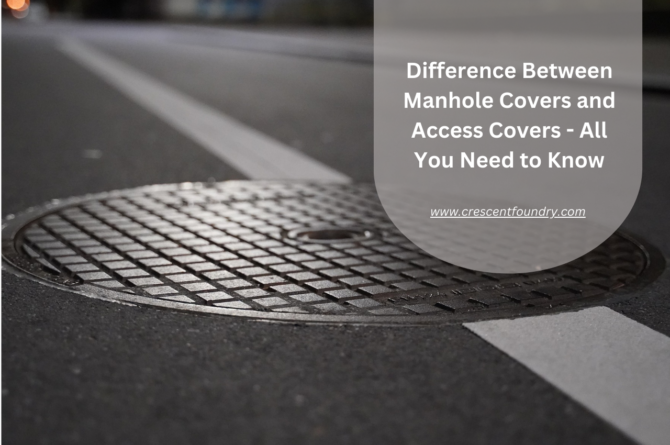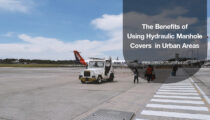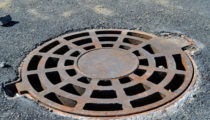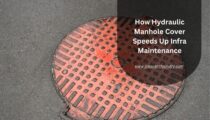The role of technology in transforming the quality, reliability, &…

Difference Between Manhole Covers and Access Covers – All You Need to Know
Whether you appreciate it for keeping unauthorized stuff out of the sewerage or hate it for being a bump on your way, you simply can’t ignore the piece of invention that is a manhole cover! Found in numbers in any given neighborhood, manhole covers are basically lids shut over large sewerage openings. But there is more below the surface of urban areas than just sewerage.
A world of electrical wiring clusters, basements, and maintenance crawl spaces lie under what meets the eye, all needing seamless covers for entrances that open onto public areas. Access covers, like manhole lids, are meant for safe access to concealed regions, housing heating and ventilation ducts, plumbing, electrical wiring, and more.
Though similar in configuration, manhole covers and access covers differ in their use cases. Read more to find out how:
Engineering Material
Traditionally, manhole cover manufacturers have come to favour cast iron while designing sturdy lids for drainage or sewerage openings. With a massive tensile strength of more than 420 Mpa and a yield strength of more than 300 Mpa, cast iron makes for an extremely economical option while also ensuring great durability.
You can avail two types of cast iron manhole covers from heavy-duty foundries – ductile cast iron and grey cast iron. Having a graphite microstructure, grey cast iron lids are heavier, corrosion resistant, easy to weld, while also having a high galling-resistance capacity.
Access covers, on the other hand, are most commonly found in stainless steel, galvanised steel, and aluminium. The choice of material of access covers depends on the type of industrial area where it is being used, and the load classes for different use cases, as per EN 124.
Stainless steel is considered appropriate for access covers in the food industry, chemical plants, meat storage units, and beverage product manufacturing and packaging units. As for shopping malls and retail outlets, residential areas and private villas, access covers typically used are made of galvanised steel.
At slightly more demanding spaces that see hundreds of footfalls a day, like hotels and hospitals, typically found access covers are of aluminium. Owing to its lightweight property and corrosion-resistance, aluminium is favoured for designing lids installed in interior commercial spaces. An aluminium square plate can visually blend with floor tiles of light hues and also ensure effortless lifting for easy access into maintainance chambers under the surface.
Load Capacity
Light duty covers, having a load capacity up to 2.5 tonnes, are popular for gardens, patios, and driveways – whereas more hardy covers are crucial for industrial estates, docks, airports, loading bays and the like.
Access covers generally do not require a load capacity exceeding 6.5 tonnes unless they are used on the road. Out-of-door access covers may be required to withstand heavy-duty pressure, up to 11.5 tonne pneumatic tyre wheel load.
In both manholes and other kinds of under-surface recesses, the weight withstood is distributed along the length of a downwards-extending vertical grate. Since the Bureau of Indian Standards have not yet come up with a specific code for cover weightage, most access and manhole cover manufacturers would adhere to the European EN 124. According to this statute, there are six distinct load classes in which both types of covers are available:
- A 15: A 15 covers can take loads of 15kN or 1.5MT, perfect for pedestrian lanes and cycling lanes.
- B 125: More durable than A 15s, B 125 covers can withstand a pressure of 125kN or 12.5MT, making them suitable for car parks.
- C 250: Trust C 250s to bear weights up to 250kN or 25 MT, making these ideal for kerbside traffic.
- D 400: Perfectly suited to bear loads of 400kN or 40 MT, D 400s are good to use on hard shoulders by motorways, car parks, and areas of dense vehicular traffic.
- E 600: Suited to bear hefty loads of 600kN or 60 MT, E 600s satisfactorily endure surface pressure at shipyards, runways, and loading docks.
- F 900: F 900 platforms hold out against 900kN or 90 MT of load in areas of high wheel traffic, as in airport runways.
Type of Subsurface Recesses
Manhole covers and access covers both conceal under-surface utility lines for various infrastructural channels. They secure water sewers, telephone cabling, electricity lines, storm drains, heating pipes, and gas lines running underground. While manhole covers typically safeguard under-surface sewerage lines, access covers come between the world above and the relatively drier utility spaces down below.
Going down any manhole, the first part to encounter will be the access shaft which is the entryway to the depths of the recess. This area also facilitates a maintenance ladder for climbing down. Further to the bottom is the cleaning and inspection chamber of the manhole, followed by an inverted chamber. This is a small buffer zone created to prevent possible backflow of sewage through the system.
Access covers typically lead to passages or trenches containing service wiring, signals, heating and cooling shafts, crawlspaces of ventilation channels and more. Compared to subsurface spaces covered by manhole lids, access covers secure less damp recesses. Electrical wiring under-panels, gas line trenches, or maintenance crawl spaces typically lie on the flipside of access covers.
Aesthetics
Leading manhole cover manufacturers of India are greatly sensitive to spatial aesthetics of cover installation for subsurface recesses. Manhole lids and access covers come in a variety of finishes for seamlessly blending into different kinds of floorings. However, compared to manhole tops, more intricate and fine inlay options are available in access covers.
You can pick access covers installable in driveways, car parks, curbsides, and other out-of-door spaces in tiles that blend with the rest of the space. Since manhole covers tend to be heavier in design, the infills may be less consistent with the surrounding area.
For middle-of-the-road coverings, manhole lids are most commonly given a smooth steel finish and are usually raised above the ground. You can also find manhole covers with aesthetic engravings.
An industry leader in heavy-duty metal-cast products, Crescent Foundry offers a range of covers for concealing various types of undersurface recesses. Covers are meant for extensive use, with each installation typically enduring for at least a decade. Make your choice critically after considering the product by the parameters stated above.



